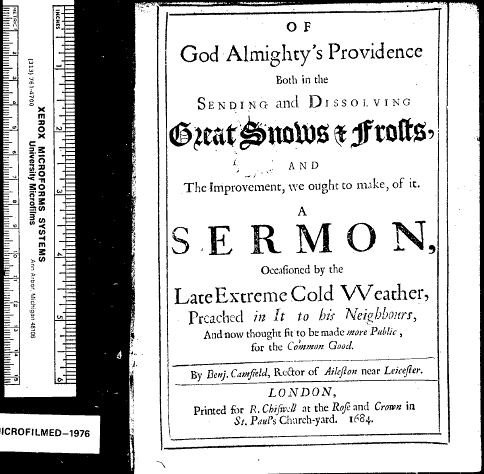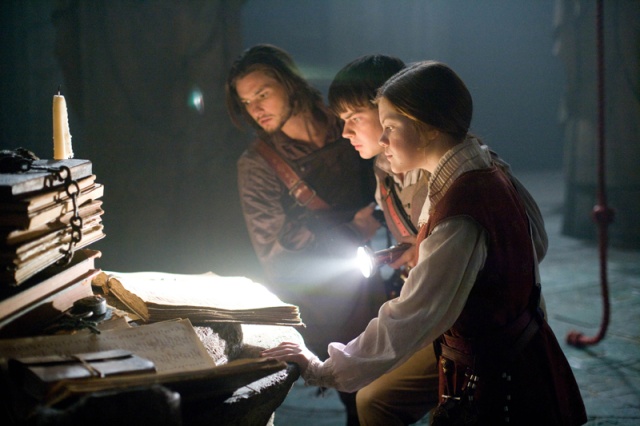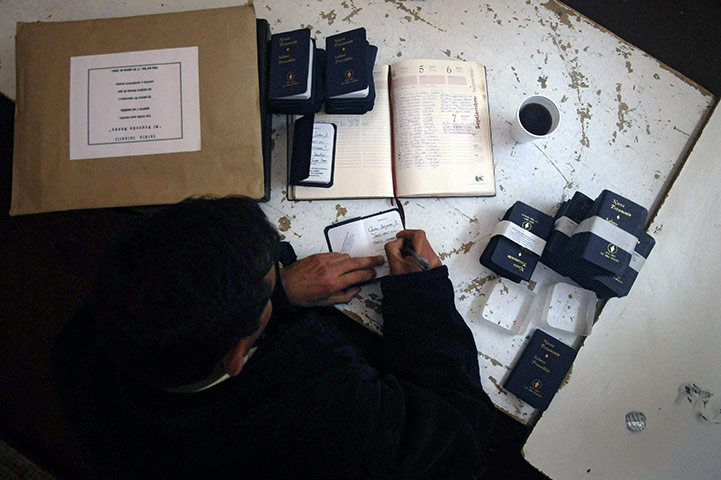The newspapers and other media are of course delighting in the unusually severe weather currently affecting the UK and Europe, with apocalyptic headlines and images dominating print and broadcasting. A casual search of EEBO reveals some of the kinds of God-fearing and similarly sensationalist texts produced in response to extreme snows four or five hundred years ago. On a broadsheet from 1571, for example, is printed ‘A prayer to be sayd in the end of the mornyng prayer daily (through the dioeces of Norwich) during the tyme of this hard and sharp wether of frost and snow to craue mercye for our synnes and release of this sore punishment at the mercifull handes of our good and gracious God’. About a century later, in the same year the above sermon was printed, another broadsheet told of ‘Sad news from Salisbury, and other parts of the west of England. Being an account of a most sad and dreadful frost and snow, which hapned on the 23d. of December 1684. in and about most parts of the west of England, which froze to death many poor passengers who travelled the rode, besides many beasts, incredible to believe, but that some who were in the same storm are alive to justify the truth thereof … To the tune of, Aim not too high’…
chained books, somewhere in Narnia
Michael Apted’s film adaptation of C.S. Lewis’s third Narnia chronicle The Voyage of the Dawn Treader, on general release in the UK since last week, stars the kind of elaborate material texts that are becoming commonplace in new fantasy films. Those who remember the BBC’s version of the Chronicles of Narnia from the early 1990s probably recall the hand-drawn map in the opening sequence of each episode, over which, accompanied by haunting horn music, the viewer was drawn into the mysterious lands of Lewis’s imagination. Like others of its genre, this new film takes delight in the dramatic and cinematic possibilities of maps, diaries, and books that can be transformed through computer technology. When Lucy finds a book of incantations in a library in the invisible mansion, for example, the film indulges in a not strictly necessary scene of CGI magic emanating from this generically ‘old’ (probably folio) volume resting on a quasi-ecclesiastical lectern. Lucy and the others are then shown a map of the islands they must find, which when unrolled before them becomes distinctly ipad-like with its touchscreen Google Earth capabilities. It’s interesting how, as computer and film technologies become more sophisticated, they don’t move away from but seem to return increasingly to the iconic and dramatic potential of more traditional material texts, even as they transform them.
This small but very moving exhibition at the Foundling Museum, Bloomsbury, opened in October and continues until March 2011. The Foundling Museum tells the story of Thomas Coram’s Foundling Hospital, the first home for abandoned children and the first public art gallery in Britain, which Coram founded in the mid-eighteenth century with the philanthropic involvement of figures including William Hogarth and George Handel. Over the centuries that followed, the Hospital cared for thousands of babies found on the streets or brought to its doors by mothers who could not afford to look after them.
Threads of Feeling puts on public display for the first time an astonishing archive of texts and textiles from the 1740s to the 1760s, the early decades of the Foundling Hospital. When a baby was admitted, a record was created on a printed registration form. The admission process was usually anonymous – the name of the baby’s mother was not included, and the baby was given a new name. Attached to each registration form was a small token. This could be a little medal, toy, ornament, or ribbon, but most often these tokens were pieces of fabric cut from the infant’s clothing. These tokens were kept as a method of identification in case a mother ever returned to reclaim her child.
In their hundreds these admission forms were kept and bound into ledgers, creating not only a record of the children who were cared for by the Hospital, but also an important social history of clothing, fashion, and textiles in the mid-eighteenth century. Because they have been bound up inside these ledger books, these scraps of fabrics are very well preserved. The London poor were not dressed in the black and white of Hogarth’s moralising prints, but in vivid shades and designs that emulated sumptuous and expensive fashions, and the descriptive notes accompanying each scrap record a rich vocabulary of these textiles: camblet, fustian, susy, cherryderry, calamanco, linsey-woolsey…
The scraps are incredibly poignant, each telling the story of an individual child and his or her mother, bearing witness to an identity and a relationship that was replaced when the child was taken in by the Hospital and given a new name as well as the chance of a new life. They are often explicitly textual, with names, messages, prayers, or a date added in ink or embroidery, for example. The vibrancy of the fragments that make up this textual and material archive contrasts powerfully with the sadness of the poverty and desperation they record.
If you’re visiting the ‘Journey through the Afterlife: Ancient Egyptian Book of the Dead’ exhibition at the British Museum (mentioned on this blog a few weeks ago) you might want to extend your stay with a visit to the free, smaller exhibition, ‘Images and Sacred Texts: Buddhism Across Asia’, open until April 2011.
The Buddhist religion centres on the ‘three jewels’; the Buddha, his teachings, and the community of the faithful, and this exhibition explores how these are depicted across geographical and chronological distances. The exhibition brings together an astonishing range of images and artefacts from Asian lands over the last two thousand years, amongst which the exquisitely decorated Buddhist texts, on palm leaves and paper, promise a fascinating insight into the spread of this faith and its philosophy through and beyond Asia. Again, do leave comments below after your visit!
One of this winter’s exhibitions at the British Museum, ‘Journey through the Afterlife: Ancient Egyptian Book of the Dead’, opens on Thursday. The exhibition website explains that the ‘Book’ was ‘not a single text but a compilation of spells designed to guide the deceased through the dangers of the underworld, ultimately ensuring eternal life.’ This is the first time that many of these unique works from the British Museum’s collection have been shown in a public exhibition. The oldest examples of these illustrated texts on papyrus and linen were written over 3,500 years ago, and they will be displayed alongside other objects connected to death, burial, and beliefs about afterlife in Ancient Egypt. The museum website doesn’t give away much more about these mysterious texts, but promises advanced technological elements in the exhibition to enrich the visitor’s experience and understanding of these fragile documents. There is a series of public lectures and events too, details available here. If readers of this blog can enlighten us further about these fascinating material texts after visiting the exhibition, please feel free to comment below!
This was the provocative title of BBC Radio 3’s Night Waves programme yesterday evening. Philip Dodd chaired a panel in Alnwick made up of novelists David Almond and Louise Welsh, historian Sheila Hingley, and Chris Meade, co-director of the Institute for the Future of the Book, which discussed the rising popularity of e-readers and the consequences of this new technology for readers, writers, and publishers.
Amongst the panel and the audience there was widespread agreement that reading books is a multi-sensory experience involving more than ‘reading text’. Hingley commented that a book is ‘more than a vehicle for text’, and we wouldn’t want to ‘curl up in bed with a piece of plastic’. Many audience members shared personal stories illustrating the importance of the physical as well as the intellectual and emotional pleasure of the book as a distinctive object to be shared and treasured – elements of reading which are absent from the experience of the e-reader.
Louise Welsh insisted on the democracy of the book in contrast with the expensive e-reader. She reminded us that a history of reading involves a history of access to knowledge, and suggested that because it costs hundreds times more than a cheap paperback, the e-reader is a less democratic medium for reading. As Jason’s most recent post here highlighted however, other manifestations of digital media have been responsible on an immeasurable scale for the democratisation of knowledge and writing. The panel praised the possibilities of the internet, such as fan fiction sites, through which readers can increasingly become writers themselves. David Almond pointed out that children and young people are a significant constituency of this democracy of reading and writing. While he said it was patronising to suggest that young people today are so familiar with screen technologies that books do not appeal to them, he noted that children’s literature in particular has been creative and experimental with different forms of and beyond the printed book, and should not be overlooked in this kind of debate.
Most enthusiastic about digital books was Chris Meade, who suggested that Dickens or Blake would have been excited by the opportunities offered by the e-reader. To be suspicious of the e-book on aesthetic terms is to succumb to nostalgia, he said; rather, we should resist defining ‘literature’ as something only found printed on paper, and embrace the possibilities of collaborative writing, print-on-demand, and new flexible boundaries of publication. Members of the audience drew attention to some valuable practical uses of the e-reader – a librarian from Newcastle commented that it could have significant benefits for borrowers who are limited by the size of print in books, and that with an e-reader housebound borrowers could potentially gain access to many more books than previously.
No matter how sleek and clever new screen technologies might be, the printed book is a ‘design classic’, someone put it. The e-reader looks as though it is here to stay, at least for the foreseeable future, and the panel agreed that we should think of this new relationship between the book and the e-book as not antagonistic and ‘either/or’, but as potentially mutually beneficial…
If you’re interested in hearing the whole debate, the programme is available to ‘listen again’ on BBC iplayer until 22 October 2010.
The American Library Association’s Banned Books week began on 25th September. This annual celebration of the ‘freedom to read’ raises awareness of attempts to remove particular books from schools, libraries, and other institutions, as well as official state censorship. The ALA’s Office for Intellectual Freedom compiles a database of ‘challenged books’ each year based on newspaper reports and information from the public – should you come across an attempted book suppression, you can report it online via the rather sinister Challenge Reporting Form…
Over here in Europe, this month also sees the centenary celebrations for one of Hungary’s most important twentieth-century poets, György Faludy (1910-2006). Faludy first became known for his translations and rewritings of Franςois Villon’s ballads in the 1930s, but the story of the publication of these and all his subsequent writing is bound up with a traumatic period in the history of central Europe. Faludy’s criticism of the totalitarian regimes in his native country resulted in multiple periods of exile and imprisonment during the 1940s and 1950s. In Hungary his books were burned by the ruling fascist Arrow Cross party in the 1940s, and pulped during the communist regime that followed. For many decades his work circulated in samizdat printings.
Faludy spent several years in the forced labour camp at Recsk, where he sustained the spirits of the other prisoners by giving lectures and readings, and composed poetry without any writing tools. After the revolution of October 1956, he settled in London, subsequently moving to Canada where he lectured at universities there and in the USA and Europe. He returned to Hungary in 1988, when at last his work began to be published openly. Even in 1985, the Preface to an English edition of the Selected Poems 1933-1980 stated ‘Another Hungarian periodical committed a kind of suicide last year when it published an essay pointing out how ludicrous it was that, although Faludy was beyond doubt Hungary’s greatest poet, none of his works could be printed or purchased in his native country’.
The works in Selected Poems 1933-1980, ed. and trans. Robin Skelton et al (Athens: University of Georgia Press, 1985), make frequent allusions to books, conveying Faludy’s profound sense of the printed word as something simultaneously dangerous and vulnerable. With ‘In the Reading Room of the British Museum’ (London, 1967) Faludy celebrates the intellectual freedom of his regular Reading Room companions in a place ‘where factory whistles never sound, and money/ never talks – where silence hovers over worth’. These people, liberated by reading, will ‘on their deathbeds’ know ‘in silence what a billion men/will never know: that, living, they were alive’. In ‘Tibet’ (London, 1957) Faludy contrasts a peaceful domestic scene of reading and writing with the political events happening in the Far East: ‘Standing at monastery windows/ they are throwing out books’. These powerful images of destruction remind Faludy of his own country and its sufferings: ‘Wretched we who left Hungary,/ wretched those left behind’. The volume concludes with ‘Learn by heart this poem of mine’ (Toronto, 1980), in which he laments
[…]
books only last a little time
and this one will be borrowed, scarred,
burned by the Hungarian border guards,
lost by the library, broken-backed,
its paper dried up, crisped and cracked,
worm-eaten, crumbling into dust,
or slowly brown and self-combust
when climbing Fahrenheit has got
to 451, for that’s how hot
your town will be when it burns down.
Learn by heart this poem of mine.
The poem anticipates an apocalyptic destruction of humanity by itself, and the surprising final line – ‘You must forget this poem of mine’ – reminds us of the controversial issues of materiality that always surround the works of writers with views considered unsavoury by those in power. Sometimes even the human memory, Faludy suggests in this poem, is too dangerous a place for words to be preserved.
Yet more material texts in the headlines for political reasons: as the ninth anniversary of the terrorist attacks on the World Trade Centre in New York approaches, a preacher in Florida has announced his intention to burn copies of the Qur’an outside his church on Saturday. Needless to say, his views have provoked horror and outrage. Again, without wishing to over-simplify the complex issues surrounding this threat and the responses it has had from across the globe, this incident is a dramatic reminder of the political importance of all sacred texts as material objects which symbolise tolerance and respect.
A poignant image from the news this week: miniature bibles about to be sent 700 metres underground to the 33 men trapped in a Chilean mine. This scene illustrates starkly the practical importance of the materiality of texts – only volumes as small as these will fit in the narrow tube that connects these men to the surface. In this extreme but real-life context, the physical properties of these books have as much significance as their textual content. (Photo from www.guardian.co.uk).
Has anyone been to ‘The Sculpture of Language’, a current exhibition curated by Poet Laureate Carol Ann Duffy at the Tate Liverpool? It’s one of the three parts of the DLA Piper series ‘This is Sculpure’ (the other two are ‘Sculpture: The Physical World’ and ‘Sculpture Remixed’), each of which has been developed by Tate curators alongside leading cultural figures from a range of disciplines. From the Tate collection Duffy has chosen works from 1699 to the present day which engage in some way with written words, including pieces by David Kindersley, Eric Gill, Sonia Delauney, and Salvador Dali. Duffy has contributed a specially-written sonnet, ‘POETRY’, to the exhibition too. More can be read about ‘The Sculpture of Language’ here. I’m interested in how this kind of exhibition investigates the ways in which artists working with different media respond to words and language, and invites us to reconsider text in the context of other art forms. If you’re in Liverpool during the next few months, this certainly looks worth a visit.


